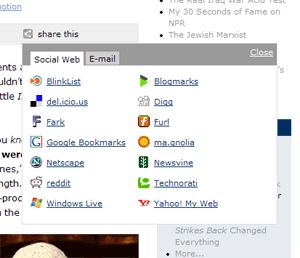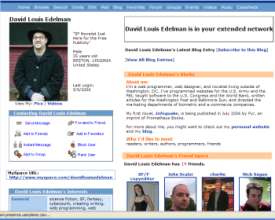Fortune Magazine’s David Kirkpatrick recently took a gander at the iPhone hype and concluded that the Apple model of music distribution is a thing of the past. “I doubt most people will want to buy or ‘own’ music at all,” writes Kirkpatrick in his article Looking Beyond the iPhone. “It will be far more useful to pick from a giant online library and listen to whatever we want wherever we are.”
The author then goes on to hold up as a model for the future RealNetworks’ Rhapsody service, which RealNetworks CEO Rob Glaser calls “the jukebox in the sky.” It sounds like a great deal: $10 a month for all the streaming music you can listen to. The catch is that you don’t get to own any of it; everything resides on the Rhapsody servers, you’re just checking it out for a few minutes.
 Let’s put aside the fact that RealNetworks’ products turned into clunky, adware-laden pieces of crap several years ago with the release of their RealOne player. Let’s also put aside the fact that the company has lost so much ground in recent years to Apple’s iTunes and Microsoft’s Windows Media that they hardly have the clout to revolutionize the music business anymore.
Let’s put aside the fact that RealNetworks’ products turned into clunky, adware-laden pieces of crap several years ago with the release of their RealOne player. Let’s also put aside the fact that the company has lost so much ground in recent years to Apple’s iTunes and Microsoft’s Windows Media that they hardly have the clout to revolutionize the music business anymore.
The real (Real) question is this: Do people want a jukebox in the sky?
Kirkpatrick points to the coming ubiquity of wireless broadband networking. Within the next ten years or so, we’ll all be using 3G or WiMax or some as-yet-unchristened technology to access information anytime, anywhere. You won’t need to bring your music with you on little metallic discs — or little plastic iPods — because it will all be available for the taking on the big jukebox in the sky. Why pay to “own” music at all when downloading it is effortless? Just download what you want, when you want.
But here’s the problem with that scenario. Broadband access isn’t the only technology that’s growing by leaps and bounds. Disk storage is exploding too, and getting cheaper by the day.
As I write this, I’m looking at a last-generation iPod sitting on my desk with 30 GB of storage. Not quite enough to store my whole music collection yet — I rip my MP3’s at a full 320 Kbps, as God intended them to be ripped — but the newer 80 GB iPods might do the trick. Within a few years, we’ll be carrying 500 GB iPods. Seagate and Hitachi have 1 terabyte hard drives coming out this year. Flash memory is getting so cheap that you can find piles of thumb drives sitting next to the check-out counter at computer stores.
Guess how much data the entire printed Library of Congress contains? 10 terabytes. Yes, that’s it, 10 terabytes. Assuming we continue along this exponential trend of increased storage, you’ll be blowing your nose with 10-terabyte Kleenex soon enough. What does that mean? That means you’ll be able to carry your entire music, video, and book collection around in your pocket in 20 years. Let’s take it even further: in 40 or 50 years, you’ll be able to carry around every book ever written and every piece of music ever recorded around with you. Give it another 10 years for video.
So would you rather carry your digital media with you in your pocket, or would you rather carry your radio receiver with you and access your media on the great jukebox in the sky?

 After poking around a bit on the blog, I discovered that David’s part of a three-person team that produces the online comic strip The DADA Detective. (See the snippet to the right.)
After poking around a bit on the blog, I discovered that David’s part of a three-person team that produces the online comic strip The DADA Detective. (See the snippet to the right.) Gmail should be a slam-dunk for Google. After all, I can build a simple POP3 application on a ColdFusion web server in a couple of hours, and that includes time for me to consult the Macromedia documentation to fix my mangled CFML syntax. I’m not saying that that’s all there is to it, of course. (If you want to see a ColdFusion-based application gone horribly awry, look at all the
Gmail should be a slam-dunk for Google. After all, I can build a simple POP3 application on a ColdFusion web server in a couple of hours, and that includes time for me to consult the Macromedia documentation to fix my mangled CFML syntax. I’m not saying that that’s all there is to it, of course. (If you want to see a ColdFusion-based application gone horribly awry, look at all the  Mind uploading is a transhumanist concept wherein you take a human brain and digitize it. We’re not just talking about scanning and mapping here; the goal is to have a fully functioning mind that can exist outside of all this defective muscle, bone, and tissue you cart around with you. Science fiction authors have been kicking the idea around forever. Wikipedia cites Philip K. Dick and Roger Zelazny as some of the earliest SFnal treatments of mind uploading, but you could make a good argument that Mary Shelley got there first with her Frankenstein, or the Modern Prometheus in 1818.
Mind uploading is a transhumanist concept wherein you take a human brain and digitize it. We’re not just talking about scanning and mapping here; the goal is to have a fully functioning mind that can exist outside of all this defective muscle, bone, and tissue you cart around with you. Science fiction authors have been kicking the idea around forever. Wikipedia cites Philip K. Dick and Roger Zelazny as some of the earliest SFnal treatments of mind uploading, but you could make a good argument that Mary Shelley got there first with her Frankenstein, or the Modern Prometheus in 1818. He’s almost right. If you don’t like the way the world is, now you can edit your version of it with Greasemonkey.
He’s almost right. If you don’t like the way the world is, now you can edit your version of it with Greasemonkey. Here’s the problem: MySpace is an abomination. Nothing works. The things that do work are poorly designed and shoddily implemented. Here’s just a small sampling of problems I’ve been having:
Here’s the problem: MySpace is an abomination. Nothing works. The things that do work are poorly designed and shoddily implemented. Here’s just a small sampling of problems I’ve been having: